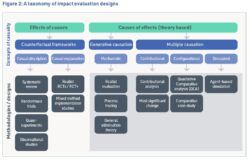How do small n impact evaluations work?
Small n impact evaluations draw on different understandings of causation from ‘traditional’ counterfactual impact evaluations.

All the small n methodologies that we describe have certain elements in common:
- Mid-level theory: All the approaches to impact evaluation associated with uncovering ‘causes of effects’ involve specifying a mid-level theory or a Theory of Change together with alternative causal hypotheses. Causation is then established beyond reasonable doubt by collecting evidence to validate, invalidate or revise hypothesised explanations (White and Phillips 2012). Mid-level, or middle range, theory is a sociological concept that attempts to combine high-level abstract concepts with concrete empirical examples. As such, it makes hypothesis development possible by bringing data and evidence together with theoretical constructs to help make sense of the subject under investigation. Mid-level theories can also support a focus on causal mechanisms operating at a more general level than the context of specific individual interventions. As a result, they encourage the identification of patterns and ‘regularities’ across a range of interventions or contexts. This process can support the development of generalisable conclusions and, therefore, the transfer of hypotheses between related interventions or contexts.
- Cases: Key to all small n approaches is the concept of the ‘case’. However, small n methodologies are not ‘case studies’. Small n, case-based methodologies are varied but Befani and Stedman-Bryce (2017) suggest that case-based methods can be broadly typologised as either between-case comparisons (for example, qualitative comparative analysis) or within-case analysis (for example, process tracing).
- Mixed method: Generally, quantitative and qualitative data are used, with no sharp distinction made between quantitative and qualitative methods.
- Complexity: In counterfactual approaches, the two concepts of bias and precision are central to managing uncertainty. Sources of uncertainty are controlled through both research design (randomisation where possible and sample size/statistical power) and precision (e.g. methods of statistical inference, computation of confidence intervals, p-values, effect sizes and/or Bayes factors). In contrast, small n approaches are case-based, and the multifaceted exploration of complex issues in real-life settings allows these approaches to account for uncertainty through invoking concepts centred on ideas of complexity.
- Generative and multiple causation: Within approaches to small n impact evaluation, Stern and colleagues (2012) make a broad distinction between approaches based on generative causation and those based on multiple causation. Multiple causation depends on combinations of causes that lead to an effect, whereas generative causation understands causation as the transformative potential of a phenomenon and is closely associated with identifying mechanisms that explain effects (Pawson and Tilley 1994).